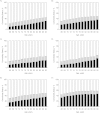Assessing non-cancer-related health status of US cancer patients: other-cause survival and comorbidity prevalence
- PMID: 23825168
- PMCID: PMC3816346
- DOI: 10.1093/aje/kws580
Assessing non-cancer-related health status of US cancer patients: other-cause survival and comorbidity prevalence
Abstract
With advances in prevention, screening, and treatment, cancer patients are living longer; hence, non-cancer-related health status will likely play a larger role in determining their life expectancy. In this study, we present a novel method for characterizing non-cancer--related health status of cancer patients using population-based cancer registry data. We assessed non-cancer-related health status in the context of survival from other causes of death and prevalence of comorbidities. Data from the Surveillance, Epidemiology, and End Results program (2000-2006) were used to analyze cancer patients' survival probabilities by cause of death. Other-cause survival was estimated using a left-truncated survival method with the hazard of death due to other causes characterized as a function of age. Surveillance, Epidemiology, and End Results data linked to Medicare claims (1992-2005) were used to quantify comorbidity prevalence. Relative to the US population, survival from a non-cancer-related death was higher for patients diagnosed with early stage breast and prostate cancer but lower for lung cancer patients at all stages. Lung cancer patients had worse comorbidity status than did other cancer patients. The present study represents the first attempt to evaluate the non-cancer-related health status of US cancer patients by cancer site (breast, prostate, colorectal, and lung) and stage. The findings provide insight into non-cancer-related health issues among cancer patients and their risk of dying from other causes.
Keywords: SEER; cancer survival; cancer survivorship; comorbidity; health status; left-truncated survival; non-cancer-related survival; other-cause mortality.
Figures




References
-
- Coleman MP, Quaresma M, Berrino F, et al. Cancer survival in five continents: a worldwide population-based study (CONCORD) Lancet Oncol. 2008;9(8):730–756. - PubMed
-
- Howlader N, Noone AM, Krapcho M, et al. SEER Cancer Statistics Review, 1975–2008. Bethesda, MD: National Cancer Institute; 2011. http://seer.cancer.gov/csr/1975_2008/ (Accessed February 1, 2012)
-
- Siegel R, DeSantis C, Virgo K, et al. Cancer treatment and survivorship statistics, 2012. CA Cancer J Clin. 2012;62(4):220–241. - PubMed
-
- Marubini E, Valsecchi MG. Analyzing Survival Data from Clinical Trials and Observational Studies. New York; Chichester: John Wiley & Sons; 1995.
MeSH terms
LinkOut - more resources
Full Text Sources
Other Literature Sources
Medical

